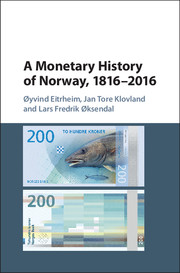Book contents
- Frontmatter
- Contents
- List of Figures
- List of Tables
- Preface
- 1 A Monetary History in Five Parts
- PART I THE LONG PROMISE, 1816–1850
- PART II THE RISE OF PRIVATE DEPOSIT-TAKING BANKS, 1850–1914
- 4 Newfound Stability in Times of Crisis and Financial Breakthrough, 1850–1870
- 5 Volatility and Stability in the Time of Gold, 1870–1892
- 6 Stability in Times of Crisis and Growth, 1892–1914
- PART III WORLDWAR I AND TURBULENT INTERWAR YEARS, 1914–1940
- PART IV MONEY IN TIMES OFWAR, CENTRAL PLANNING AND REGULATION, 1940–1986
- PART V THE LONG RETURN, 1986–2016
- Bibliography
- Index
5 - Volatility and Stability in the Time of Gold, 1870–1892
from PART II - THE RISE OF PRIVATE DEPOSIT-TAKING BANKS, 1850–1914
Published online by Cambridge University Press: 09 February 2017
- Frontmatter
- Contents
- List of Figures
- List of Tables
- Preface
- 1 A Monetary History in Five Parts
- PART I THE LONG PROMISE, 1816–1850
- PART II THE RISE OF PRIVATE DEPOSIT-TAKING BANKS, 1850–1914
- 4 Newfound Stability in Times of Crisis and Financial Breakthrough, 1850–1870
- 5 Volatility and Stability in the Time of Gold, 1870–1892
- 6 Stability in Times of Crisis and Growth, 1892–1914
- PART III WORLDWAR I AND TURBULENT INTERWAR YEARS, 1914–1940
- PART IV MONEY IN TIMES OFWAR, CENTRAL PLANNING AND REGULATION, 1940–1986
- PART V THE LONG RETURN, 1986–2016
- Bibliography
- Index
Summary
Introduction
The previous chapter told the history of two international financial crises that tested the commitment of the monetary authorities to maintaining currency convertibility and a well-functioning monetary system. In turn, the crises influenced their understanding of their task. Moreover, the chapter covered the breakthrough of deposit banking, which transformed the financial landscape of Norway and provided a new important channel for monetary growth. Furthermore, we discussed the beginning of the prolonged process in which Norges Bank came to develop features that resemble modern central banking, not least the shift away from long-term lending to discounting and a more active approach to bank rate setting.
The two decades covered here, the 1870s and 1880s, lack the dramatic financial crises that shaped the time around the middle of the century. The financial sector continued to grow along the lines established earlier, but no fundamental shift took place. It was growth in scale, foremost through a geographical dispersion of banking, not in scope, a widening of type of business undertaken or of source of funding.
Lack of financial crises proper does not imply a lack of drama. Indeed, the 1870s and 1880s witnessed some of the most dramatic shifts in fortune in modern Norwegian economic history. The period started off with a flourishing boom only to be arrested by a most severe recession 1877–1879. The volatility continued into the 1880s. This was not unique for Norway but reflected an international period of deflation, sluggish growth and high volatility. For obvious reasons these movements play centre stage in this chapter with an emphasis on the relationship between international business cycles, the domestic economy and monetary development.
Although it was a time of great volatility, the international monetary regime was stable. In the course of the 1870s, the gold standard became the first truly international monetary regime. A stable regime, however, does not necessarily translate into monetary (i.e. price) stability. In a steadily more integrated world economy, an open regime will serve as a transmitter of price movements and business cycles, reducing the already low barrier between international and domestic money. In these decades, the Norwegian money supply was subject to abrupt shifts originating from abroad. How this affected Norway and influenced monetary policy will be an important theme of this chapter.
- Type
- Chapter
- Information
- A Monetary History of Norway, 1816–2016 , pp. 175 - 217Publisher: Cambridge University PressPrint publication year: 2016

